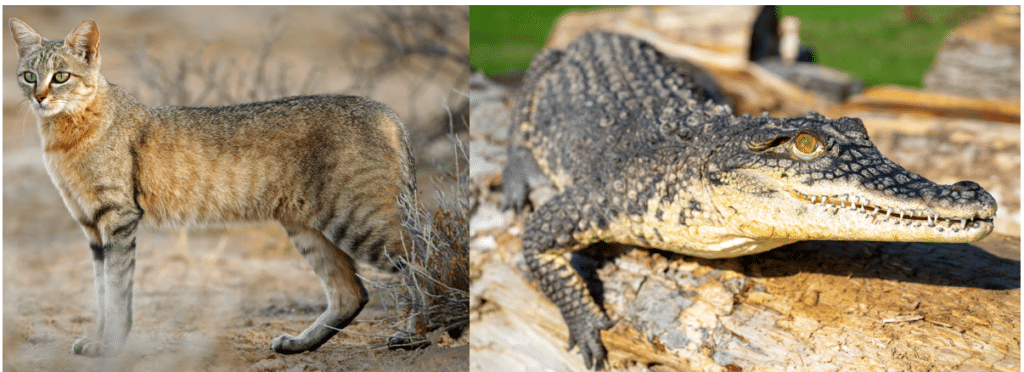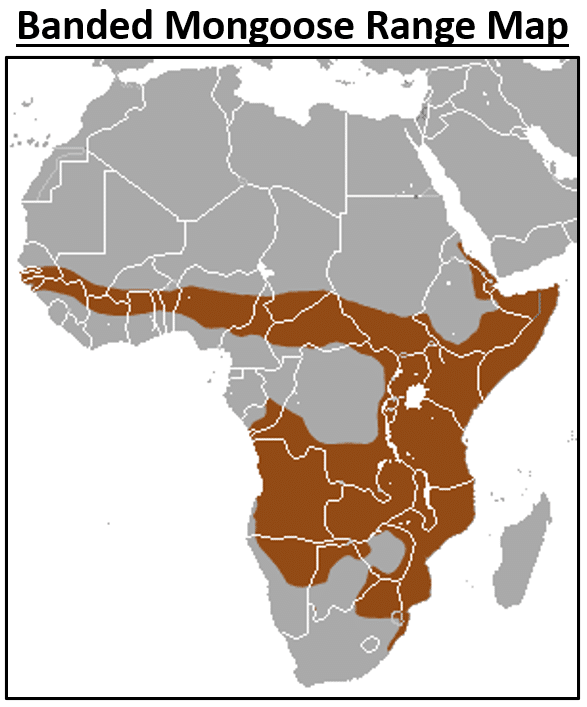6 Fierce PREDATORS found in Nigeria! (2025)
What are the different kinds of PREDATORS found in Nigeria?

These are often the first animals you think of when you imagine visiting Nigeria! The exciting, beautiful, and sometimes terrifying carnivores are some of the most fun to learn about. 🙂
In this article, you’ll find interesting facts, photos, and even range maps of these amazing animals!
6 Predators Found in Nigeria:
#1. Lion
- Panthera leo

Identifying Characteristics:
- Adults are 160-208 cm (63-82 in) long.
- They have short tawny coats, white undersides, and long tails with black tufts at the ends.
- Males have manes, while females do not.
These predators range throughout savannas and plains in Nigeria.
They prefer areas with plenty of cover and prey. In the past, lions had a much larger range, and some populations still live in semi-desert, forested, shrubby, and mountainous habitats.
Though intimidating, lions aren’t very effective hunters on their own. Instead, lions usually hunt in groups, called prides, to take down large herbivores like zebras, impalas, gazelles, wildebeests, giraffes, and cape buffalo.
Lions live in groups called prides which range from 2-40 individuals, though they are rarely all together at once. Female pride members are all related, as females don’t leave their mother’s territories. Females don’t have a dominance hierarchy and instead work together to find food and care for each other’s cubs.
On the other hand, males are generally forced out of their father’s territory at about 2.5 years of age, roam for two to three years, and then attempt to take over a pride by seriously injuring or killing the current leaders and their cubs. While we often picture one male as the “king,” male lions sometimes form coalitions of 2-4 males to take over a pride. These coalitions are often brothers, and the larger the coalition, the longer they’ll be able to reign over their pride.

While they don’t have natural predators, lions are still susceptible to starvation and attacks from humans. Their worldwide populations have declined significantly throughout their range. Sadly, some subspecies of lions are critically endangered, and some are already extinct.
#2. Spotted Hyena
- Crocuta crocuta

Identifying Characteristics:
- Adults are 95–166 cm (37–65 in) long.
- They have sandy yellowish or gray course, wooly coats with black or dark brown spots on their bodies though these may be absent in old individuals.
- They are strongly built with massive necks, large heads, rounded ears, bushy-tipped tails, and longer front legs than back legs.
Spotted Hyenas are some of the most unique predators in Nigeria!
These odd animals live in clans of 3-80 hyenas. Females lead the clans, and all of the females within the clan are dominant over all males. Males and females, there are separate dominance hierarchies.
One of the strangest features about these carnivores is that males and females are very difficult to distinguish. Females have skin and tissue in their genital area that allows them to mimic males, which may protect females from aggression from other females.
Female Spotted Hyenas are incredibly dedicated mothers. Incredibly, they nurse their young until 12 to 16 months of age. By the time the young are weaned, they already have all of their adult teeth which is very rare among carnivorous animals in Nigeria.
Spotted Hyenas have a reputation as cowardly scavengers that steal food from other predators, but researchers have found that they kill most of their prey. Despite their odd, sloped appearance, hyenas are incredible runners and will chase prey for long distances at speeds up to 65 kph (40 mph). They usually work in groups to take down large animals.

Although Spotted Hyenas are not currently endangered, they are “Conservation dependent,” meaning that there are currently programs in place to protect them. If the conservation efforts were removed, their populations would begin to decline within five years.
#3. Banded Mongoose
- Mungos mungo

Identifying Characteristics:
- Adults are 30-45 cm (12-18 in) long.
- They have large heads, long tails, small ears, short, muscular limbs, five toes on their front feet with long, curved claws, and four toes on their back feet with shorter, heavier claws.
- They have course brownish-gray coats with dark bands on their backs, dark feet, black-tipped tails, and gray-brown to orange noses.
These cat-like predators live in varied habitats in Nigeria.
Look for the Banded Mongoose in grasslands, woodlands, brushlands, and rocky country. They have large ranges, and individuals may travel more than 8 km (5 m) per day while foraging.
They’re primarily insectivores, feeding on termites, earthworms, grasshoppers, scorpions, slugs, and snails, but they’ll also feed on fruit, snakes, crabs, eggs, birds, and rodents. To break hard food like eggs and snails, they throw it at another hard object like a rock.
Banded Mongooses are social and usually live in packs of 10-20 individuals. That said, they’re very possessive of their food and eat it immediately without sharing. Typically, there is one dominant male in each pack.
Incredibly, mating is often synchronized so that the pack’s young are all born within a few days of each other. The entire pack will help care for the young, and lactating females will nurse any baby.
When it’s time to hunt, a few females stay behind to look after the young. Despite this careful guarding, only about 50% of young mongooses make it to 3 months of age.
#4. Honey Badger
- Mellivora capensis

Identifying Characteristics:
- Adults are 55–77 cm (22–30 in) long.
- They have stocky bodies, large heads, small eyes, strong, wide forefeet, small hind feet with short claws, muscular necks and shoulders, and thick, loose skin.
- Their color varies with subspecies, but generally, their lower half is black, and they have an upper mantle of gray or bright white.
Honey Badgers are one of the toughest carnivores in Nigeria!
They have a reputation for being able to live anywhere, eat anything, and survive no matter what. Look for these resourceful creatures in forests, grasslands, woodlands, deserts, rocky hills, and arid steppes. You’re likely to find them near sheltered spots like burrows and rock crevices.
Their diet is as varied as their habitat. Honey Badgers are opportunistic foragers whose menu changes with the season and prey availability. They frequently prey on snakes, birds, eggs, frogs, and small rodents.
As their name suggests, they’re also known for raiding honey bee hives to eat the larvae and honey inside. While they are primarily carnivores, Honey Badgers also enjoy fruits, roots, and bulbs.
Honey Badgers are known for their aggressive nature. Males will ferociously defend their territory and mate from other males. Naturalists sometimes refer to older adult males as “scar backs” because they usually have a noticeable patch of scars on their backs from conflicts.
The video below is one of my favorites and shows how TOUGH Honey Badgers are! Seriously, you have to watch until the end.

#5. African Wolf
- Canis lupaster

Identifying Characteristics:
- Adults stand about 40 cm (16 in) tall at the shoulder.
- They have relatively long pointed snouts and ears, comparatively short tails, and robust teeth.
- They’re yellowish to silvery gray with reddish legs, black speckling on their tails and shoulders, and some white markings on their faces, throats, and abdomens.
Look for this carnivore during the day in Nigeria in grassland areas.
African Wolves have an extensive range, and their appearance and size vary with location. They usually center their territory around a den, often made from a modified aardvark or warthog den, where the female will have her pups.
African Wolves have flexible social structures that are largely dictated by prey availability. Each pack consists of a monogamous breeding pair that remains together constantly. It also includes current offspring and previous generations that help to raise their siblings.
These wolves can be formidable predators in Nigeria, sometimes taking prey up to three times their own weight. However, they usually go after much smaller animals.
Pairs of wolves often hunt gazelle fawns and other small mammals like cane rats and ground squirrels. They also consume fruit, snakes, and insects. Interestingly, during the wildebeest calving season, African Wolves feed almost exclusively on wildebeest afterbirth.
#6. African Civet
- Civettictis civetta

Identifying Characteristics:
- Adults are 67–84 cm (26–33 in), with a 34–47 cm (13–19 in) long tail.
- They have large hindquarters, low heads, and short manes that extend down their backs.
- Coloration is silverish or cream with black or brown markings and spots, a black raccoon-like face mask, and white neck stripes.
If you see this predator in Nigeria, you might not know exactly what you’re looking at!
African Civets are incredibly unique. They have some similar features to raccoons and cats but aren’t related to either. Their large hindquarters and extended mane are dead giveaways that you have found an African Civet.
These unusual-looking animals will live in both forested and open areas, but they need plenty of cover for hunting and hiding from larger animals. For example, in open areas, they require tall stands of grasses or thickets to shelter in during the daytime.
African Civets are primarily nocturnal but occasionally move around during the morning or evening of cloudy days. They’re secretive and solitary except when they come together to breed.
Despite being a relatively shy animal, they can become a nuisance to farmers. Occasionally, they go after poultry and young lambs. When catching live prey, they overpower it with their teeth rather than their paws.
Check out these other guides about animals found in Nigeria!
-
50 Most Common Animals Found in Nigeria!
-
The 23 MOST Common Birds in Nigeria!
-
The 13 Types of Snakes That Live in Nigeria! (ID Guide)
-
2 COMMON Spiders found in Nigeria!
Which of these predators have you seen before in Nigeria?
Leave a comment below!







